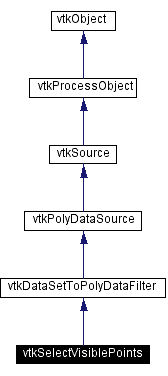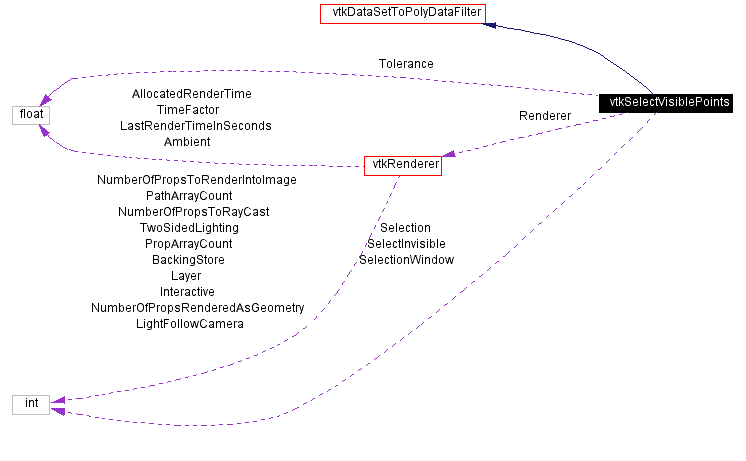Main Page Class Hierarchy Alphabetical List Compound List File List Compound Members File Members Related Pages
vtkSelectVisiblePoints Class Reference
extract points that are visible (based on z-buffer calculation).
More...
#include <vtkSelectVisiblePoints.h>
Inheritance diagram for vtkSelectVisiblePoints:
 [legend]Collaboration diagram for vtkSelectVisiblePoints:
[legend]Collaboration diagram for vtkSelectVisiblePoints: [legend]List of all members.
[legend]List of all members.
Detailed Description
extract points that are visible (based on z-buffer calculation).
-
Date:
-
2001/11/13 14:17:29
-
Revision:
-
1.20
vtkSelectVisiblePoints is a filter that selects points based on whether they are visible or not. Visibility is determined by accessing the z-buffer of a rendering window. (The position of each input point is converted into display coordinates, and then the z-value at that point is obtained. If within the user-specified tolerance, the point is considered visible.)
Points that are visible (or if the ivar SelectInvisible is on, invisible points) are passed to the output. Associated data attributes are passed to the output as well.
This filter also allows you to specify a rectangular window in display (pixel) coordinates in which the visible points must lie. This can be used as a sort of local "brushing" operation to select just data within a window.
-
Warning:
-
You must carefully synchronize the execution of this filter. The filter refers to a renderer, which is modified every time a render occurs. Therefore, the filter is always out of date, and always executes. You may have to perform two rendering passes, or if you are using this filter in conjunction with vtkLabeledPointMapper, things work out because 2D rendering occurs after the 3D rendering.
-
Examples:
-
vtkSelectVisiblePoints (Examples)
-
Tests:
-
vtkSelectVisiblePoints (Tests)
Definition at line 84 of file vtkSelectVisiblePoints.h.
Constructor & Destructor Documentation
| vtkSelectVisiblePoints::vtkSelectVisiblePoints |
( |
|
) |
[protected] |
|
| vtkSelectVisiblePoints::~vtkSelectVisiblePoints |
( |
|
) |
[protected] |
|
Member Function Documentation
| virtual const char* vtkSelectVisiblePoints::GetClassName |
( |
|
) |
[virtual] |
|
| int vtkSelectVisiblePoints::IsTypeOf |
( |
const char * |
type |
) |
[static] |
|
|
|
Return 1 if this class type is the same type of (or a subclass of) the named class. Returns 0 otherwise. This method works in combination with vtkTypeMacro found in vtkSetGet.h.
Reimplemented from vtkDataSetToPolyDataFilter. |
| virtual int vtkSelectVisiblePoints::IsA |
( |
const char * |
type |
) |
[virtual] |
|
|
|
Return 1 if this class is the same type of (or a subclass of) the named class. Returns 0 otherwise. This method works in combination with vtkTypeMacro found in vtkSetGet.h.
Reimplemented from vtkDataSetToPolyDataFilter. |
| vtkSelectVisiblePoints* vtkSelectVisiblePoints::SafeDownCast |
( |
vtkObject * |
o |
) |
[static] |
|
| void vtkSelectVisiblePoints::PrintSelf |
( |
ostream & |
os, |
|
|
vtkIndent |
indent |
|
) |
[virtual] |
|
|
|
Methods invoked by print to print information about the object including superclasses. Typically not called by the user (use Print() instead) but used in the hierarchical print process to combine the output of several classes.
Reimplemented from vtkSource. |
| vtkSelectVisiblePoints* vtkSelectVisiblePoints::New |
( |
|
) |
[static] |
|
|
|
Instantiate object with no renderer; window selection turned off; tolerance set to 0.01; and select invisible off.
Reimplemented from vtkPolyDataSource. |
| void vtkSelectVisiblePoints::SetRenderer |
( |
vtkRenderer * |
ren |
) |
[inline] |
|
|
|
Specify the renderer in which the visibility computation is to be performed.
Definition at line 97 of file vtkSelectVisiblePoints.h. |
| vtkRenderer* vtkSelectVisiblePoints::GetRenderer |
( |
|
) |
[inline] |
|
| virtual void vtkSelectVisiblePoints::SetSelectionWindow |
( |
int |
|
) |
[virtual] |
|
|
|
Set/Get the flag which enables selection in a rectangular display region. |
| virtual int vtkSelectVisiblePoints::GetSelectionWindow |
( |
|
) |
[virtual] |
|
|
|
Set/Get the flag which enables selection in a rectangular display region. |
| virtual void vtkSelectVisiblePoints::SelectionWindowOn |
( |
|
) |
[virtual] |
|
|
|
Set/Get the flag which enables selection in a rectangular display region. |
| virtual void vtkSelectVisiblePoints::SelectionWindowOff |
( |
|
) |
[virtual] |
|
|
|
Set/Get the flag which enables selection in a rectangular display region. |
| virtual void vtkSelectVisiblePoints::SetSelection |
( |
int |
, |
|
|
int |
, |
|
|
int |
, |
|
|
int |
|
|
) |
[virtual] |
|
|
|
Specify the selection window in display coordinates. You must specify a rectangular region using (xmin,xmax,ymin,ymax). |
| virtual void vtkSelectVisiblePoints::SetSelection |
( |
int |
[4] |
) |
[virtual] |
|
|
|
Specify the selection window in display coordinates. You must specify a rectangular region using (xmin,xmax,ymin,ymax). |
| virtual int* vtkSelectVisiblePoints::GetSelection |
( |
|
) |
[virtual] |
|
|
|
Specify the selection window in display coordinates. You must specify a rectangular region using (xmin,xmax,ymin,ymax). |
| virtual void vtkSelectVisiblePoints::GetSelection |
( |
int |
data[4] |
) |
[virtual] |
|
|
|
Specify the selection window in display coordinates. You must specify a rectangular region using (xmin,xmax,ymin,ymax). |
| virtual void vtkSelectVisiblePoints::SetSelectInvisible |
( |
int |
|
) |
[virtual] |
|
|
|
Set/Get the flag which enables inverse selection; i.e., invisible points are selected. |
| virtual int vtkSelectVisiblePoints::GetSelectInvisible |
( |
|
) |
[virtual] |
|
|
|
Set/Get the flag which enables inverse selection; i.e., invisible points are selected. |
| virtual void vtkSelectVisiblePoints::SelectInvisibleOn |
( |
|
) |
[virtual] |
|
|
|
Set/Get the flag which enables inverse selection; i.e., invisible points are selected. |
| virtual void vtkSelectVisiblePoints::SelectInvisibleOff |
( |
|
) |
[virtual] |
|
|
|
Set/Get the flag which enables inverse selection; i.e., invisible points are selected. |
| virtual void vtkSelectVisiblePoints::SetTolerance |
( |
float |
|
) |
[virtual] |
|
|
|
Set/Get a tolerance to use to determine whether a point is visible. A tolerance is usually required because the conversion from world space to display space during rendering introduces numerical round-off. |
| virtual float vtkSelectVisiblePoints::GetTolerance |
( |
|
) |
[virtual] |
|
|
|
Set/Get a tolerance to use to determine whether a point is visible. A tolerance is usually required because the conversion from world space to display space during rendering introduces numerical round-off. |
| unsigned long vtkSelectVisiblePoints::GetMTime |
( |
|
) |
[virtual] |
|
|
|
Return MTime also considering the renderer.
Reimplemented from vtkObject. |
| void vtkSelectVisiblePoints::Execute |
( |
|
) |
[protected, virtual] |
|
|
|
This method is the old style execute method
Reimplemented from vtkSource. |
Member Data Documentation
vtkRenderer* vtkSelectVisiblePoints::Renderer [protected]
|
|
int vtkSelectVisiblePoints::SelectionWindow [protected]
|
|
int vtkSelectVisiblePoints::Selection[4] [protected]
|
|
int vtkSelectVisiblePoints::SelectInvisible [protected]
|
|
float vtkSelectVisiblePoints::Tolerance [protected]
|
|
The documentation for this class was generated from the following file:
Generated on Thu Mar 28 14:42:29 2002 for VTK by
 1.2.11.1 written by Dimitri van Heesch,
© 1997-2001
1.2.11.1 written by Dimitri van Heesch,
© 1997-2001



 1.2.11.1 written by Dimitri van Heesch,
© 1997-2001
1.2.11.1 written by Dimitri van Heesch,
© 1997-2001